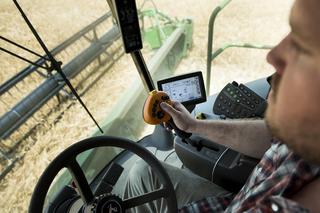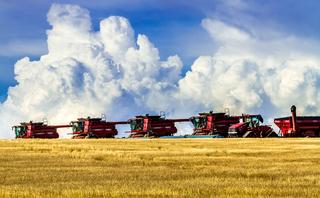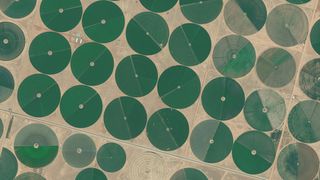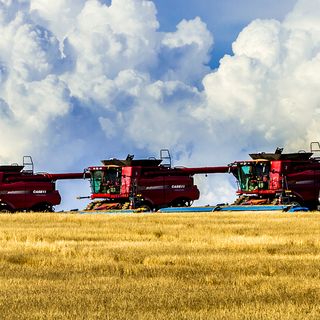Key takeaways
- Currently known as the world’s least digitised industry, agriculture is experiencing a digital revolution driven by global trends that are laying the foundations for new agricultural production systems and supply chains.
- Agriculture is a critical sector for Australia’s economy, with exports to markets in the Asia-Pacific region expected to grow significantly in coming decades.
- Implementing digital technologies in agriculture will be critical for Australia’s ability to meet growing global demands and remain competitive in global markets.
- Awareness of the digital agriculture opportunity is emerging in Australia, with interest growing amongst entrepreneurs and investors, and strong support from government.
- Digital agriculture technology maturity culminates in the development and deployment of predictive and prescriptive data analytics platforms, and the United States is leading.
- In Australia, the current state of both development and adoption of digital agriculture technology is less mature than the United States; centred on single use-case solutions, enabled by descriptive and diagnostic analytics.
- Barriers exist in Australia that are limiting the development and the widespread diffusion of digital agriculture technologies, and therefore the maturation of the sector.
- Overcoming these barriers by bridging the disconnect of expectations between Australian farmers and the technology community, and creating solutions with strong value propositions, requires investors and entrepreneurs to understand the many complexities faced by Australian farmers.
The global digital agriculture movement, led by the United States
Imagine a future where farming is a high-tech profession, agriculture has an ever-greater positive impact on our natural resources, food waste is eliminated and the world’s growing population has enough of what they need (and want) to eat every day. As digital technologies — from artificial intelligence and the internet of things (IoT) to distributed ledger technologies such as blockchain — are brought to food and agriculture value chains around the world, this possible future is seeming more like a near-term reality.
Momentum is undeniably growing for the digitisation of agriculture, as macro trends of population growth, shifting consumer preferences for “cleaner” foods, constrained natural resources, the increasingly connected nature of the world and the growing importance of data and services in global trade flow continue to fuel the uptake of digital technologies.
Combined with the opportunity for innovation in the world’s least digitised industry,1 these trends are exciting investors, entrepreneurs and governments. Increasingly, investment is flowing into digital agriculture technologies globally.
Pitchbook, a venture capital data research company, indicates US$812 million of venture capital has been deployed into AgTech between 2014 and 2016.2 Much of this digital technology development is driven by investment from the United States. In the first half of 2017, US venture capital investment in AgTech accounted for 47 per cent of global capital deployed.3 Most of these investments came from California, with its thriving technology ecosystem in Silicon Valley and a significant agriculture region in the nearby Central Valley.4
The United States is leading the growth of digital agriculture technologies, enabled by a number of key factors in addition to the unique capital investment environment of Silicon Valley.
The US Department of Agriculture (USDA) has helped to create enabling conditions for the advancement of digital agriculture. For example, the USDA publishes comprehensive and publicly available agricultural datasets, such as soil maps, in conjunction with extensive climatic data from a dense network of radar and reporting stations. Entrepreneurs and researchers are able to develop technologies based on these highly detailed, geography-specific data.5
In addition to a comprehensive mobile telecommunications infrastructure throughout key cropping regions in the United States, the USDA, through the broadband loan and grant program, is also working to provide broadband access to rural areas.6 To reach their full potential benefits, digital technologies in agriculture often require access to telecommunications networks, for example to transmit information between devices or store data collected from remote sensors.
Land grant universities7 are becoming more aware of the opportunities afforded by digital agriculture technologies and collaborating to drive value for their communities. Last year, Cornell University and John Deere — a world-leading manufacturer of agricultural machinery and equipment — began a collaboration to develop a data platform using the John Deere Operations Center to provide farmers with analytics derived from their farm data.8 Michigan State University currently hosts the Midwest Cover Crop Calculator, a web-based decision tool for cover crops created in collaboration with several other land grant universities.9 Massachusetts Institute of Technology (MIT), in partnership with Rabobank, hosts the Rabobank-MIT Food and Agribusiness Innovation Prize, an early-stage prize competition for agriculture technology companies.10
Australia’s digital agriculture progression
In Australia there is an increasing understanding of the potential opportunities promised by digital agriculture and its importance to the future of Australia’s food and fibre industries.
Agriculture is a critical component of the Australian economy. In the 2016-17 financial year, agriculture was worth more than A$63 billion,11 making up making up 3 per cent of Australia’s GDP,12 with exports accounting for over 75 per cent of this value.13 In the same year, food exports constituted 11.6 per cent of all goods exports.14
Looking forward, Australia is well placed to capitalise on growing global demands for food and fibre, especially from the Asia-Pacific region. Projections by Brookings in 2017 suggest the middle class of the Asia-Pacific region will be approximately 153 per cent larger in 2030 than in 2015, and will represent 65 per cent of the global middle class.15 Australia is proximate to Asia, already has established export channels and maintains a reputation for clean and high-quality produce.16 In coming decades it is likely the international demand for Australian agricultural products will increase, as will the significance of the agricultural sector to the Australian economy. Capitalising on this opportunity will rely, in part, on the development and adoption of digital agriculture technology solutions: The National Farmers’ Federation has forecast that by 2030, the value of Australian agriculture has the potential to increase to A$100 billion.17
According to recent research from the ‘Accelerating Precision Agriculture to Decision Agriculture’ research project (P2D), gains from digital agriculture could increase the gross value of Australian agricultural production, including forestry, fisheries, and aquaculture, by A$20.3 billion. This is equivalent to a 25 per cent increase in the value of agricultural production in 2014-15. These gains would also add A$24.6 billion to overall Australian GDP.18 There’s significant value on the line for the agriculture industry in Australia.
According to recent research, gains from digital agriculture could increase the gross value of Australian agricultural production, including forestry, fisheries, and aquaculture, by A$20.3 billion — equivalent to a 25 per cent increase.
The support ecosystem for innovation in agriculture, including (but not limited to) digital technologies, is rapidly maturing. Australia now has seven active accelerator and incubator programs dedicated to food and agriculture, including two with associated venture capital funds.19 Australian innovators are already producing world-leading digital technologies across a diverse range of applications in agriculture. Such innovations include CSIRO-patented virtual fencing technology, sensor and artificial intelligence-based microclimate forecasting systems, and cloud-based applications for scarce water management.20
Australian digital agriculture technology innovators are attracting capital as well. In December 2017, hyperspectral imaging start-up Flurosat raised A$1.5 million,21 and in February 2018 AgriDigital raised A$5.5 million for its blockchain-enabled commodity management system.22
Australia’s capabilities in digital agriculture technologies extend beyond the entrepreneurial and technology communities. For example, Australian farmers have a track record of successfully adopting technologies. Analysis from one of Australia’s big four banks, ANZ, has shown that an increase in access to technology since 1995-96, facilitated by a transition into larger scale farming, has led to a 62 per cent increase in output.23 In more recent years, the uptake in technology-related capital — including fixed assets, appliances, industrial and electrical machinery and equipment, and products based on intellectual property — has been growing at five times the rate of overall capital. Projections by the Australian Bureau of Statistics (ABS) show Australian farming is on track to increase its stock of technology-related capital by almost 42 per cent by 2030.24
Beyond historical trends, Australian farmers are optimistic about the prospects of digital technologies and innovations for their business. In an Agri Insights survey of 1,400 producers conducted by one of Australia’s big four banks, the Commonwealth Bank in late 2016, 70 per cent of respondents believed available digital technology can add significant value to operations, while 20 per cent were looking to focus their financial investment in technology in the next 12 months. Self-described first adopters of digital technology made up 22 per cent of respondents.25

Governments in Australia are also contributing to the development of digital agriculture technologies. Investment analysis conducted by the United States Studies Centre finds more than A$30 million has been delivered to digital agriculture start-ups between 2013-17 from a range of federal and state government sources.
Government-led research is also playing a role. The P2D project, supported by funding from the Rural R&D for Profit Program and collaboration across all Rural Research and Development Corporations (RDCs), has been critical to understanding three key elements: the potential value that can be unlocked for Australian agriculture through the application of digital technologies; the challenges that hinder the adoption of digital agriculture technologies; and the need for a strategy to increase digital maturity in the sector.
In summary, Australia is well placed for the digital revolution in agriculture:
- Momentum and support exist for an imperative to develop digital technologies for the benefit of Australian agriculture;
- There’s a historical culture of adoption of innovative technologies amongst Australian farmers, combined with an optimistic attitude towards digital technologies within the farming community; and
- A growing awareness of the importance of these technologies exists within government at all levels.
What are digital agriculture technologies?
Digital agriculture, at a basic level, promises to help farmers do more with less through data-driven decisions and technologies that optimise the farming environment. These technologies allow farmers to generate greater yields with greater efficiency, while minimising the environmental impact of their operations. Digital agricultural technologies also create new ways of increasing transparency along the supply chain and building trust with consumers.
The Food and Agriculture Organization of the United Nations projects that by 2050, global food production will have to increase 60 per cent to meet global demand. Of the necessary global production increase in food supply, 85 per cent will come from increased yields and cropping intensity, for which agricultural technologies will be absolutely critical.26
There are many categorisations of technologies within agriculture,27 and in all cases digital technologies are only a subset. For the purposes of this report, digital agriculture technologies include software and hardware applied on farm or at any point of the agricultural supply chain, excluding consumer-facing products and services. This includes Precision Ag Software, Sensors and IoT Platforms, Imagery Platforms, Smart Farm Equipment, and most Ag Marketplace/Supply Chain and Logistics Technologies.
Digital agriculture technologies are merely the latest of several technological revolutions in history to transform agriculture, with potential for improvements in productivity. Previous agricultural revolutions included the mechanical and scientific revolutions in the 20th century.28 29
The table below shows common focus areas of digital technology companies in agriculture, and examples from the United States.
|
Potential benefit |
Example US companies[^30] |
|
Reducing costs |
Blue River Technology employs computer vision and robotics technologies to build intelligent, automated solutions for weed spraying that makes management decisions on each individual crop, thereby reducing herbicide usage and costs. Blue River Technology was acquired by John Deere for US$305 million in 2017. FarmWise has developed a weeding robot that uses computer vision to identify weeds and robotics to remove them from vegetable farms without the use of herbicides. Their 2017 seed funding raised US$5.7 million.[^31] |
|
Improving on farm decision-making through data |
Granular is a software and analytics platform that helps farmers operate more efficiently and make better business decisions. Granular was acquired by DowDuPont for US$300 million in 2017. TerrAvion uses low altitude imagery and data to bring actionable insights about crop health and irrigation to the agriculture industry. TerrAvion’s 2017 Series A funding raised US$10 million.[^32] |
|
Reducing or eliminating waste |
Spoiler Alert has developed a software solution that integrates with existing enterprise systems to help food businesses, distributors, farms and nonprofits better manage unsold food inventory. 2016 seed funding of US$2.5 million.[^33] Impact Vision uses hyperspectral imaging, image recognition and predictive learning to allow business across the agricultural supply chain to assess the quality and safety of food products with a greater degree of accuracy. This allows agribusinesses to improve quality guarantees of products and reduce waste. 2017 seed funding of US$1.4 million.[^34] |
|
Building trust and increasing transparency between farmers and consumers |
Ripe.io is using sensor, IoT, and blockchain technologies to create greater visibility in the agricultural supply chain for farmers, distributors and consumers and engender transparency of product quality, trust and brand value for producers.[^35] |
A first step: Precision agriculture tools for descriptive and diagnostic analytics
Digital technologies like GPS-guided tractors, variable rate technology (VRT) and cloud-based farm and business management software programs are helping farmers to understand and record what has happened, and increasingly, what is happening right now. Sensors and farm management software are increasingly helping producers to manage their operations more precisely and accurately using data collected digitally and often stored and analysed in the cloud.
However, these descriptive and diagnostic technologies represent only the very beginning of the potential opportunity investors and start-ups see. While initially focused on precise management of agronomic data to cut costs and increase yields, start-ups and investors in digital agriculture are looking beyond optimisation to where new growth opportunities will emerge.
Farmers, too, are eager to see technology developers move beyond descriptive and diagnostic solutions. Currently available digital agriculture solutions often target a single use case (e.g., water monitoring). Even the best solutions in market today fail to provide an integrated user experience. Farmers don’t yet have a ‘one stop shop’ for their digital agriculture technologies.
Start-ups (and the investors behind them) are working hard to solve this problem by integrating data sources, scaling up data collection and analytics, and ultimately moving toward predictive and prescriptive analytics platforms.
The future of digital agriculture: Tools for predictive and prescriptive analytics
Maturation of the sector will see tools move beyond solutions that leverage descriptive, diagnostic and real-time analytics to solve single use cases. Predictive and prescriptive analytics that integrate data sources and provide practical recommendations using historical and current data — ideally from multiple sources — will be able to forecast future trends. Such products will allow farmers to manage by exception, develop a holistic picture of their current and future operations, and focus on data-driven, impactful interventions that optimise for positive business outcomes.
Capturing this growth potential, start-ups in North America have been leading the way in developing platforms for predictive and prescriptive data analytics to provide farmers with the best possible opportunity to optimise across their businesses.
The Farmers Business Network (FBN) helps farmers to optimise farming operations based on big data-enabled benchmarking of input prices (e.g., seeds and chemicals) derived from a vast national network of FBN subscribers, covering tens of millions of acres of farmland and billions of data points.36 Though FBN started by focusing on seeds, as their reach has grown they have expanded to support procurement across multiple inputs (e.g., fertilisers, pesticides), as well as crop marketing.
Similarly, Farmers Edge37 has developed FarmCommand, an all-in-one platform that integrates multiple data sources and helps farmers make data-driven decisions based on predictive analytics. Initially focused on specific precision agriculture uses cases, such as variable rate, Farmers Edge now supports farmers and their advisors to make data-driven decisions across their businesses.
Other start-ups are following closely behind, looking to develop predictive analytics platforms for specific subsectors. Aquabyte,38 for example, uses machine learning and computer vision to calculate fish size and activity to recommend quantities of feed. In the indoor farming space, Agrilyst39 has developed a virtual agronomy platform that manages operational data as well as forecasts yields.
Although descriptive and diagnostic analytics are still valuable to farmers to understand and record “what happened”, venture capital investors, especially in the United States, are increasingly drawn to digital agriculture companies selling a vision of predictive and prescriptive analytics.
|
North American predictive analytics companies |
Capital raised (USD)[^30] |
|
Farmers Business Network (FBN)[^40] |
$193.9 million (as of 30 November 2017) |
|
Farmers Edge Laboratories[^41] |
$103.6 million (as of 20 September 2016) |
|
Aquabyte[^42] |
$3.5 million (as of 30 January 2018) |
|
Agrilyst[^43] |
$2.5 million (as of 31 January 2018) |
It is this capital that enables these digital agriculture technology companies to move up the “maturity ladder” (see model below) from point solutions delivering descriptive and diagnostic analytics, to platforms delivering predictive and prescriptive analytics. Achieving the latter requires growth-focused capital that enables start-ups to invest in economies of scale and achieve network effects, beyond the focus on revenue generation. In other words, venture capital, which is more prevalent in digital agriculture technology in the United States than in Australia, is driving start-ups up the maturity ladder toward platform offerings.
AgTech maturity model 44

Barriers to maturity in digital agriculture
Capital is not the only factor required to bring digital technologies to farms. Agriculture is a tough and uncertain environment, characterised by the unpredictability of natural systems, regulatory complexity, lack of standards and often a lack of enabling conditions such as internet connectivity, especially in remote locations.
To successfully move digital agricultural development and adoption up the maturity ladder and realise more value for all involved, the sector must overcome the disconnect that remains between the experience of farmers, the aspirations of digital agriculture entrepreneurs and the expectations of their investors. Barriers exist globally, including in the United States, Australia and other developed countries.
Structural barriers
A key structural barrier constraining the maturity of digital agriculture is the lack of access to critical telecommunications and internet infrastructure in rural Australia.
A 2017 survey of 1,000 producers across 17 agricultural industries in Australia found only a third (34 per cent) of farmers have mobile coverage across their entire property, while just under half (43 per cent) have no coverage at all. While four out of five (79 per cent) producers identify internet connectivity as important to their business, less than a third (30 per cent) are satisfied with the performance of their office internet connectivity.45
The lack of key datasets is also a barrier in some countries, including Australia. Foundational datasets for soil and climatic data have been critical to fostering the development of digital technologies in the United States.46 However, similar national datasets do not exist in Australia.47 Technology developers and researchers are at a significant disadvantage without these datasets.

Familiarity and digital literacy
Low levels of digital literacy prevent farmers from adopting digital technologies, no matter how useful they may be. Many producers are not digital natives and lack familiarity with digital and data-driven systems. This is an issue globally, as well as in Australia. The average age of respondents to surveys conducted as part of the Australian P2D project was 57. As computers were not introduced to Australian schools until the mid-1980s, many survey respondents would not have had exposure to digital technologies in school.
An opportunity exists, therefore, to close this capability gap by training and deploying professionals who both understand agriculture and possess digital skills throughout the Australian agricultural sector to increase the adoption of digital agriculture technologies.48 Younger farmers, who are often digital natives, have an opportunity to take a leadership position with technology.
Value proposition of digital technologies
Farmers are keen on technology: one in five Australian farmers are generally positive about digital technologies and report looking to focus their investment in farm technology and innovation in the next 12 months.49 However, the reality is only around one in 20 make that investment.50
In some cases, the value proposition of digital technologies hasn’t outweighed the current, trusted options. In the results of a study conducted by Farmlogs, surveying more than 1,000 growers in the United States, more than 40 per cent of respondents still use spreadsheets to track expenses, 27.8 per cent use pen and paper, and 2.8 per cent don’t track expenses at all.51
A lack of a strong value proposition for farmers is a critical barrier to the adoption of currently available digital technologies, as well as to the maturation of the digital agriculture technologies sector.
Another challenge is that producers who have adopted new technologies have not seen the purported benefits. A Rabobank study of 1,000 farmers across Australia found less than a quarter were using sensor technologies with only a subset (9.2 per cent of the overall study sample) identifying an improvement in profitability from the use of this technology.52
Finally, even for technologies with a strong value proposition, such as automated harvesting that can cut labour costs, digital technologies may not yet be mature enough to deliver benefits to farmers in complex and uncertain agricultural conditions. Global AgTech market research firm Alpha Brown conducted research on the potential market for robotic harvesting solutions. Of 1,300 farmers and growers, only 3 per cent involved in the research are using harvesting robots.53
As these studies suggest, a lack of a strong value proposition for farmers is a critical barrier to the adoption of currently available digital technologies, as well as to the maturation of the digital agriculture technologies sector. Farmers need to see a clear value proposition to digital technologies before they will adopt, whether point solutions or platforms.
That’s not to say farmers are not innovative or keen adopters of technology — quite the opposite. Farmers have proven for generations that they will adopt technologies that add value. However, the value propositions that start-ups and investors are so excited about are often not consistent with the realities of agriculture and the needs of farmers. Fully autonomous farming operations managed by swarms of intelligent robots, sounds exciting, but faced with the reality of drought, poor on-farm connectivity and the day-to-day grind, it is much the same as suggesting to the average consumer that we will all soon be migrating to Jupiter. We’re just not there yet.
Advancing digital agriculture in Australia
The digital revolution in agriculture has the potential to fundamentally change the way in which our food and fibre production systems and supply chains operate. Agriculture stakeholders in Australia are beginning to see the opportunities of digital agriculture, and venture capital-backed Australian start-ups are starting to emerge.
Countries with more advanced capabilities in digital agriculture, such as the United States, have begun to demonstrate the potential of predictive and prescriptive data analytics platforms that offer ‘one stop shop’ solutions to farmers. However, whilst the international tech community is inspired by these advances, Australia’s digital technologies sector will need to adapt to the current expectations and capabilities of Australian farmers, and realities of Australian agricultural environments, before digital agriculture technology innovations can be diffused into Australian agriculture at scale.
Although there is significant and growing momentum in Australia for overcoming barriers and climbing the ladder of digital agriculture technology maturity, there is a long way to go before we realise the potential benefits.
Due to the barriers described above, and the relative lack of risk capital to fuel platform development in digital agriculture technologies, Australia is lower on the maturity ladder than other countries like the United States. However, the development and adoption of descriptive and diagnostic solutions is a critical first step for the digitisation of Australian agriculture. Predictive and prescriptive platforms will gain no traction without a foundational degree of digital capability and adoption. Developers needs to capture data and prove out initial use cases before they can develop more complex products and before growers will gain confidence in, and see results from, digital solutions.
Whilst the United States relies on an expansive start-up ecosystem to finance major technological advances, US capabilities in digital agriculture would not have been possible without the development of key communications infrastructure in agricultural regions, the availability of foundational datasets and the injection of risk capital, largely from Silicon Valley. These factors are key to facilitating the development of technologies that add value to agricultural operations and the ability of farmers to profitably adopt these technologies.
Although there is significant and growing momentum in Australia for overcoming barriers and climbing the ladder of digital agriculture technology maturity, there is a long way to go before we realise the potential benefits. All stakeholders need to remember to go step by step. This means governments that collaborate and intervene only when strategic and complementary; entrepreneurs who are laser-focused on reliable, usable products; investors who appreciate both a big vision and the realities of what it takes to get there; and primary producers who remain hungry for digital solutions. Significant adoption of integrated, multi-source, predictive and prescriptive platform solutions will happen in agriculture, starting with excellent point solutions that reliably solve practical challenges within our food and fibre industries. Let’s get climbing.







